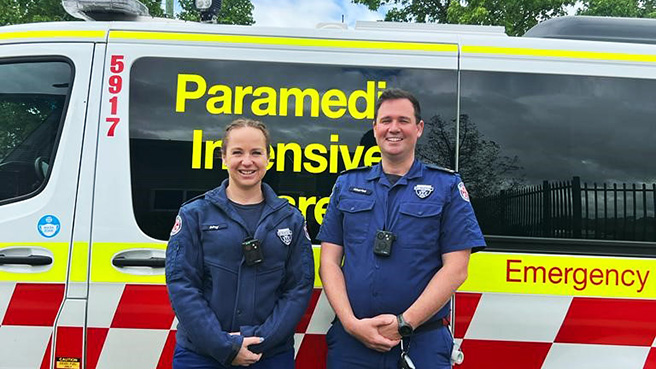
NSW Ambulance’s Body Worn Camera (BWC) Project has expanded the number of locations it is being trialled, with paramedics in Artarmon, Northmead and Wagga Wagga set to have access to the technology.
It’s the initiative aimed at mitigating incidents of occupational violence (OV) towards our staff – and now the NSW Ambulance BWC Project has expanded its trial.
It was announced last month the trial – which commenced in 2019 at Hamilton and Liverpool stations, along with the Sydney Ambulance Centre – now also includes Artarmon, Northmead and Wagga Wagga stations. Paramedics in those locations will have access to the cameras from next month.
The aim of the project is to mitigate incidents of OV through the following:
- Influencing behaviours of aggressive people through the presence, knowledge and use of BWCs;
- enabling an improved review of OV incidents reported via Incident Management System Plus (IMS+), and;
- providing evidence to NSW Police to assist with their investigations into offending against NSW Ambulance workers.
At last month’s Wagga Wagga trial launch – attended by the Hon. Bronnie Taylor MLC, Minister for Regional Health – NSW Ambulance’s Acting Director Safety and Recovery, Michal Marszalek, said paramedics may record a scene when they believe there is a significant risk of harm to themselves, their partner, their patient or any other person on scene.
“Our primary focus is to alert behaviour of people who are not behaving well to our frontline staff… it’s all about prevention,” Michal said.
The paramedic wearing a BWC will decide if and when to record a scene (once they’ve identified the significant risk to someone), and when to stop recording. The camera doesn’t record paramedics’ entire shift.
When a paramedic chooses to start recording they should tell those in the immediate vicinity the camera is recording.
This provides an assertive or aggressive person an opportunity to de-escalate their behaviour or language. If that does not occur and the scene becomes unsafe paramedics should continue to comply with OV and ‘Paramedic in Danger’ operating procedures and practices.
Wagga Wagga Paramedic Charles Milne, who already has experience with BWCs after using them during the initial trial rollout at Sydney Ambulance Centre where he was previously stationed, said he found the cameras a welcome initiative in the de-escalation of aggressive patients or bystanders.
“I have definitely witnessed de-escalation at times when there has been a patient exhibiting aggressive behaviour,” he said.
“And there has been de-escalation of bystanders as well. It’s not just patients that we interact with that are necessarily causing us potential harm. I’ve seen the cameras’ benefits when people are getting in our way and not allowing us to treat patients… this calms them down and gets them to move away.
“It’s all about defending the whole scene and making us and our patients safe.”
The expansion of the trial coincides with Charles Sturt University (CSU) recently being engaged by NSW Ambulance to conduct independent research into the efficacy of BWCs.
This ground-breaking research will collect data to determine if the presence and use of BWCs reduces the risks and incidents of OV experienced by paramedics.
The expanded trial provides CSU with a greater number of NSW Ambulance staff to engage with the research team and share experiences and opinions of BWCs and OV.
In 2019 the Surveillance Devices Act was amended to allow paramedics to record audio and video, under certain circumstances, without asking for another person’s permission to do so.
Since that time BWC footage has been successfully used by police to gain convictions against people who’ve been aggressive or violent towards paramedics. There is also speculation that the presence of NSW Ambulance-recorded footage may have led to early guilty pleas in other cases.
The NSW Ambulance BWC trial is currently scheduled to conclude in November 2023, when the amendment to the Surveillance Devices Act ends.
